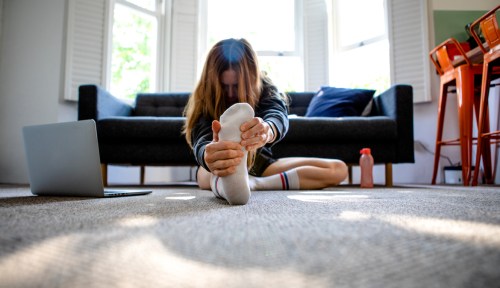Every now and then something truly miraculous happens: I arrive at my workout class really early (like 15 entire minutes early) instead of swooping in at the last minute to grab the worst spot in the studio. While I always have the intention to foam roll before I leave my house, I usually arrive to class stiff, sore, and just plain tight. So when I find myself with the extra time, I try to get a few stretches in to help shake out all of the soreness before hopping into a workout routine. While I think this is a good idea (child’s pose is the answer to everything, no?) trainers say, not so fast.
Experts in This Article
vice president of education at StretchLab
personal trainer and owner of Holly Roser Fitness
program director at Stretch*d
Why is stretching so important?
Just like you train your muscles to strengthen them, you can and should work to improve your muscles’ length and flexibility. That’s part of what will help you move throughout the world deftly and without injury, and make the most of your workouts.
“Consistent stretching trains your muscles over time to reach their optimal length,” Jeff Brannigan, program director at the mobility-focused studio, Stretch*d, in New York City, previously told Well+Good. “Over time, you are making measurable change in your body by lengthening the resting state of these muscles.”
What are the benefits of stretching?
In addition to preparing your muscles for exercise, readjusting them post-exercise, and improving mobility in the specific muscles you’re moving, stretching can have reverberating positive effects throughout the body since loosening up one area can have positive effects in other areas, too.
“For example, gaining flexibility in the shoulder area could relieve tension in the neck area as they are closely related,” Brannigan says.
Other benefits include increased blood flow, relieving stress and promoting calmness, and releasing endorphins.
Is it better to do stretching before or after workout?
Brannigan advocates for stretching every day. But where does it belong in your workout routine? Whether you should stretch before or after a workout is actually one of the most debated questions in fitness is. It turns out the answer is kinda complicated. To explain it all, I talked to Holly Roser, certified trainer and founder of Holly Roser Fitness. Below she’s breaking down everything you need to know about stretching before and after workouts, and sharing her fave stretches to try.
Should you stretch before your workout?
It turns out, not all pre-workout stretching is bad. But you do want to be careful about stretching “cold” muscles since they are more likely to tear (yikes). “It’s much easier to tear a muscle when your muscles are not warmed up,” says Roser. The same goes for stretching and working out; you should warm up first. “If you’re going from sitting at a desk all day to sprinting, you have to ensure your body is prepared for such a change, or you risk injury,” says Roser.
Once you’re all warmed up, Roser says you can do dynamic stretches, which are stretches that include movement. “Before your workout, ensure you’re warmed up for at least five minutes, ideally 10. This can include a dynamic warmup where you’re prepping your muscles for your workout by moving the joint through its full range of motion,” says Roser. “A dynamic stretching warmup will help prevent injuries and increase blood flow to the muscles being ready to use.”
What is dynamic stretching?
So what exactly is a dynamic stretch? “Dynamic stretching includes walking lunges, butt kicks, hip circles, toe to hand touches, jumping jacks, leg swings, and trunk rotations just to name a few. Dynamic stretches take your body through similar moves which you”ll be doing during your workout,” says Roser. You’ll want to add dynamic stretches into your warmup if you’re looking to increase your range of motion, activate the muscles you’re about to use, and increase your overall performance.
Should you stretch after your workout?
Now that you know which stretches to do before a workout, you’ll want to carve out a few minutes to stretch post workout too. I know it sounds like a lot of stretching, but a few minutes here and there really adds up and your body will thank you later. “Stretching post-sweat session is just as important as bringing the muscle back to its original pre-workout state,” says Roser.
After your workout is when you can do static stretches safely.
What is static stretching?
Static stretches are what you probably think of first when you think of stretches (like the classic hamstring toe-touch stretch) where you stretch a muscle and hold it in place. “If you static stretch after your workout, you’ll decrease your risk of injury, increase flexibility, and reduce soreness,” Roser says.
To get the most bang for your buck, Roser says to focus on stretching the larger muscle groups in your body like your quads, hamstrings, back, and chest muscles since these most likely need some attention no matter what workout you just completed. “Static stretching or myofascial release aids in muscle recovery, bringing increased blood flow to the area and lengthening the muscle back to its optimal state,” says Roser.
How long should I stretch before/after working out?
You should hold your static stretches for between 30 seconds and one minute, according to experts. For dynamic stretching before exercise, Harvard Health says aim for five to ten minutes of movement to ease yourself into higher intensity exercise.
Does the type of workout matter when determining when to stretch?
It’s a good idea to do dynamic stretching before a workout, and static stretching after a workout, no matter what kind of exercise you’re doing. What you want to vary based on your workout is which muscles you’re working, since it’s important to warm up the muscles you’re actually going to be using. For example, if you’re going to be doing an upper body strength session, make sure to hit those shoulder and back openers.
Should I stretch before or after lifting weights?
You can stretch both before and after lifting weights. In your pre-weight lifting session stretch, make sure to warm up the muscles you’ll actually be working. Stretching after strength training is a good idea to help you prevent soreness and prepare yourself for your next workout.
What are some tips for stretching safely?
Make sure to use proper technique when stretching to avoid injury.
“Proper technique involves having the right stabilization point and body parts anchored, which creates leverage,” Austin Martinez, CSCS, director of education with StretchLab, previously told Well+Good. “This results in you getting a deep enough stretch where needed, and ensures that you are safely stretching your body.”
Martinez also suggests to not stretch so deeply so that you feel pain, and to avoid stretching injured muscles.
Below are a few of Holly Roser’s favorite stretches to do before your workout and the ones to fit in post-sweat session for better recovery.
4 dynamic stretches to do before your workout
1. Lunge with a twist
2. Hip circles
3. Inch Worms
4. Toe-hand kicks
4 static stretches to do after your workout
1. Hamstring stretch with a towel
2. Child’s Pose
3. Quad stretch
4. Calf stretch
Sign Up for Our Daily Newsletter
Get all the latest in wellness, trends, food, fitness, beauty, and more delivered right to your inbox.
Got it, you've been added to our email list.











